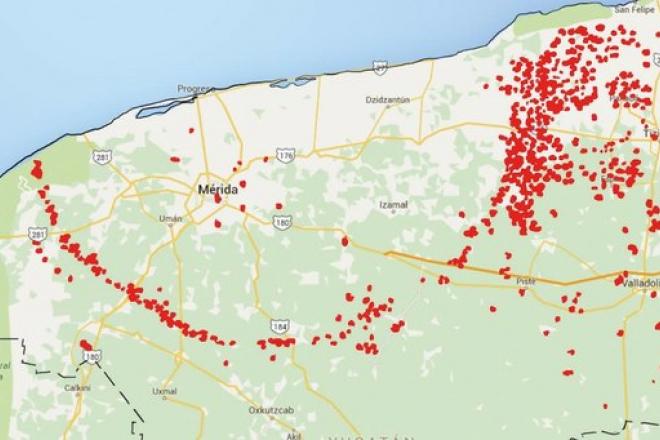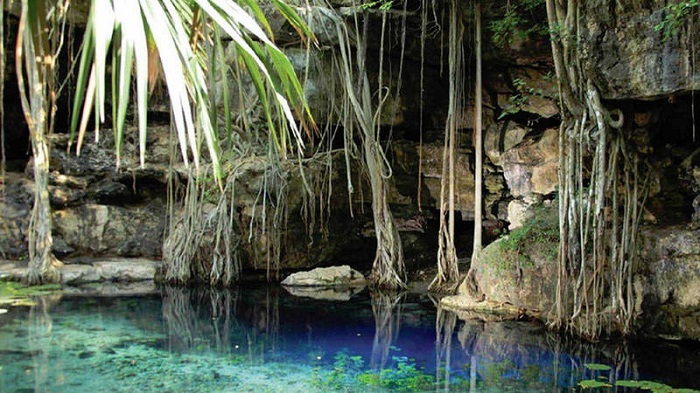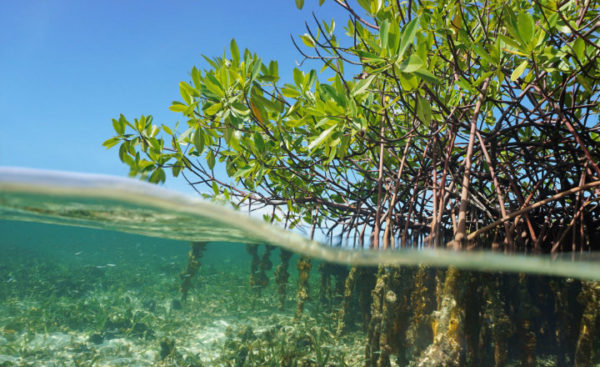World Environment Day is celebrated with the slogan “No Plastic Pollution”, a situation faced by the Entity in the Eastern Coast, where contamination of birds and fish with microplastics has been detected, as well as in the Cenotes Ring, where serious problems are being faced by garbage dumps that are already affecting these bodies of water.
In addition, deforestation is affecting the ecological reserves of the Yucatan coast, threatening the petenes, mangroves, beaches, dunes and jungles.
The eastern coast is not exempt from this serious contamination with microplastics that are invading the water and air and negatively affecting the health of humans and the environment, revealed environmental biologist Julián Rojas.
Recent studies have shown that the organisms of marine species contain toxic chemicals after consuming these tiny plastics, and it has also been proven that in the Ría Lagartos Biosphere Reserve several organisms have agrochemical residues and other contaminants that are seriously affecting this place.
The purpose of World Environment Day is to raise public awareness about the importance of caring for ecosystems and promoting respect for the environment. Experts affirm that scientific advances and solutions exist; all that is needed is political will and that all social agents join in this change to reverse the serious damage that humans have caused.
In addition to the tons of garbage left behind by tourists, including a large amount of plastic, the ecosystems have also suffered deterioration in other aspects.
Coastal Lagoon
The decrease in populations of commercially important aquatic species is one of the problems that requires attention, so that a fishing management plan can be identified and implemented. Monitoring of minimum catch sizes, closed seasons, use of fishing gear with emphasis on the shrimp triangle, number of fishermen, fishing zones, and catch of target species is recommended.
Users should play an important role in data collection. Another important aspect is to strengthen the links between those who generate the information (researchers and users) and decision makers.
The hydrodynamics of the estuary, which has been altered by artificial openings, salt extraction and road construction, has caused, among other things, siltation in some areas of the estuary, hence the importance of monitoring the basic characteristics of the estuary’s hydrodynamics and sedimentation rates.
Petenes
The selective extraction of timber trees and fragmentation by roads have been one of the most important impacts on the petenes, so maintaining the characteristics of their structure and functioning is essential. Therefore, it is advisable to carry out monitoring to characterize and quantify the use, type, quantity and area of timber extracted from the petenes and to complement this with analysis using aerial photographs and/or satellite images. It is also a priority to guarantee the freshwater supply to the area’s coastal wetland system.

Mangroves
The alteration of water flows in the mangroves has been one of the most severe impacts on the reserve. Therefore, the hydrodynamics (sea levels and water flows), structure and function of the mangroves must be characterized and monitored in order to generate information that establishes the scientific basis for mangrove management and conservation.
In ports such as San Felipe, Río Lagartos and El Cuyo, several hectares of mangroves have been cut down due to imminent population growth, putting the communities at risk from hurricanes and other natural phenomena because they do not have a buffer zone.
Beaches and dunes
The clearing of vegetation and the natural modification of the slope has been caused by human activities such as salt extraction and by natural events such as hurricanes and nortes. There is a need to monitor trends in land use changes related to salt expansion and possible construction of tourism infrastructure, as well as changes in the structure and degree of conservation of the vegetation, including endangered and threatened species.
Rainforests
Deforestation is the main impact on these ecosystems, and it has been generated mainly by extensive cattle ranching, preceded by slash-and-burn agriculture. Monitoring should record changes in land use, surface area of cattle ranching, grazing rates, and surface area of ranches that are practicing conservationist cattle ranching. The continuous use of agrochemicals, including glyphosate, has contaminated the reserve and laws are urgently needed to stop this serious problem that is affecting the fauna and flora.

Alarm in the Cenotes Ring
Multiple garbage dumps show the lack of urban planning that can be observed in the 13 municipalities that make up the Cenotes Ring Geohydrological State Reserve, which calls into question the strategies for the care and conservation of the aquifer in this area, which both inhabitants and authorities of the three levels of government must monitor and enforce.
In a tour of each of the municipalities in this reserve, open-air dumps can be observed along the roadsides. There is no community that is exempt from this type of practice.
No community is exempt from this type of practice, and these dumps are counted by the dozen throughout the area, which as a whole has a population of more than 105,000 inhabitants, equivalent to 4.5 percent of the state total, according to data from the National Institute of Statistics, Geography and Informatics (Inegi, 2020).
In Acanceh, Rufina Euán, mother of a family, expressed: “No mayor has been able to solve the garbage problem, there are times when my waste spends days waiting in the street to be collected, then there are the clandestine dumps where people abandon their waste”.
In Seyé, Jorge Cauich commented: “On the one hand the municipality is overwhelmed and on the other hand there are the citizens who most of the time leave their garbage wherever they want and do not place it in the dumpsters, this is how we see many clandestine dumps on the roadsides or in the peripheries”. In both communities, the municipal authorities were not in their offices to give their opinion on the matter.
In communities belonging to the Ruta Anillo de Cenotes tourist zone, the problem takes on a different nuance, because the waste has to be added to that generated by visitors who arrive daily at the dozens of cenotes, caves and spas in Cuzamá and Homún.
In Cuzamá, Juan Pablo Hoil, a resident of the community, said: “The authorities continually clean the sides of the main streets and the area around the main square, but the garbage ends up in the same place; there is a municipal dump where everything is piled up, compacted and burned periodically”.

Antonio Dorantes, from Homún, explained: “Here we try to take care of the image given to the tourist, but throughout the week you can notice that the garbage deposits placed in the main square are overflowing with garbage, more than anything else it is a problem that exceeds the authorities, because they barely finish collecting in one section of the town and in the others there is already garbage waiting”.
In this regard, officials of the municipalities of both towns, who requested anonymity for fear of reprisals, mentioned: “What we do not have are resources to deal with the situation, we have no budget, our trucks are more than 30 years old, they constantly break down and we have to lend or rent, another issue are the municipal employees who are paid a day, but many times we have to ask them to work until night without overtime pay”. They added: “There is an area of opportunity where the people of the community can support us, we need them to separate their waste into organic and inorganic, to recycle and reuse what is necessary”.
In Hocabá, Gumersindo Dzib, a farmer, commented: “There is no way to control so much garbage nowadays, the dumps in the gaps and on the roadsides are many, in the Sahcabá police station we had to intervene to mobilize more than three tons and a few days later they had already collected more waste”. In this municipal capital no official could be interviewed, but in the Sahcabá commissariat, commissary Gregorio Tuz pointed out that the locality does not have the resources and infrastructure to deal with the garbage problem.

“There is garbage everywhere, there are days when we agree with neighbors and on tricycles and motorcycle cabs we gather everything to take it to the dumps, then we wait for the Secretary of Sustainable Development (SDS) of the State to send trucks and personnel to take the garbage. The last time the SDS came was almost two years ago,” he emphasized.
In Huhí, Mayor Roger Benítez accepted that waste management is a problem that has been growing steadily in recent years: “Here the municipality provides waste collection services at no cost to the inhabitants, however, we have many shortcomings to address a growing need, when the truck does not work we are forced to lend, rent or have to use a patrol car to transport the garbage to the municipal dump located north of the town.
The Mayor recalls that during his first term at the head of the City Council, in 2012 the then Congressman Dafne Lopez proposed an intermunicipal management for the construction of a landfill for municipalities in the Cenotes Ring reserve, “today, more than 10 years later, the Mayors of the reserve have not made progress in this regard and the problem is growing”.
Sergio Grosjean, anthropologist, diver and promoter of the protection of the aquifer, explained: “It is important to build a sanitary landfill in the area, at present a large part of the contamination goes to the aquifer without any control, it is a terrible damage that is being caused, a good sanitary landfill would help a lot”.
Yamili Salazar, president of the Bacab A.C. group dedicated to the promotion of water care, commented: “It would be a project that must be thoroughly reviewed, to know where it would be built and what the soil in that area is like, as well as to know what capacity and how long it would last, and to be sure that it will comply with official standards”.

Santiago Chel, neighbor of Huhí, activist and member of the Ha’kanules Network dedicated to the surveillance and care of the cenotes, said: “Unfortunately the problem of waste we must face globally citizens and Government, part of the situation is due to ignorance and lack of education, I am sure that we are not aware that we live on a geohydrological reserve of a surface of more than 219 thousand hectares and that the fresh water we have in the subsoil is susceptible to be contaminated by the waste we throw, this same water is what we and people from municipalities in the North of the State consume. There is still much to be done”, he concluded.
TYT Newsroom


